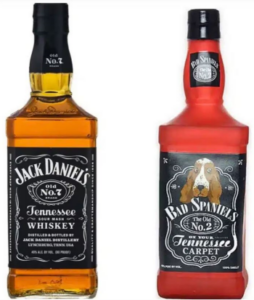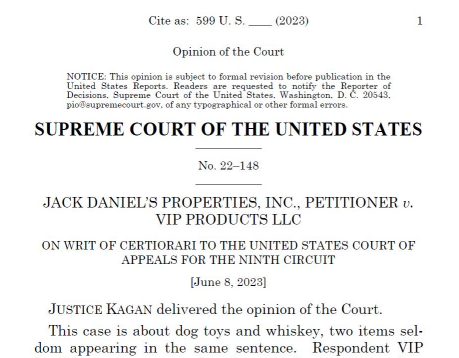
The Supreme Court decided in favor of Jack Daniel’s on its infringement and dilution claims against VIP Products, LLC (VIP). This post summarizes the facts, procedural history, and the Court’s opinion with some added commentary.
Basic Facts.
The “Jack Daniel’s” trademark is federally registered, as are features of the Jack Daniel’s label and the bottle shape. VIP has a line of dog toys that look like popular beverage brands, such as Dos Equis and Stella Artois. In 2014, VIP added the “Bad Spaniels” dog toy to its products. Jack Daniel’s contacted VIP claiming that Bad Spaniels was an infringement of its trademarks and diluted and tarnished its famous trademark by association it with dog excrement. Jack Daniel’s demanded VIP stop selling Bad Spaniels. In response, VIP filed a lawsuit in federal court seeking a declaration that Bad Spaniels did not infringe or dilute Jack Daniel’s trademarks. Jack Daniel’s made the infringement and dilution claims formal by pleading them a counterclaim against VIP.
Procedural History.
While somewhat complicated, the procedural history in the lower federal courts sets the stage. VIP moved for summary judgment in its favor on the counterclaims, which the district court denied. A nonjury trial was held before the district court judge who decided that Bad Spaniels infringed and diluted Jack Daniel’s trademarks.
VIP appealed to the Ninth Circuit. The Ninth Circuit reversed the district court (1) as to the infringement claim, remanded the claim to the district court to decide whether Bad Spaniels is an “expressive work” protected by the First Amendment which, if so, would preclude Jack Daniel’s infringement claim, and (2) as to the dilution claim, entered judgment in favor of VIP on the basis that the “noncommercial” use of Bad Spaniels is not dilution of a famous trademark.
The district court on remand decided Jack’s Daniel’s could not show facts overcoming the “expressive work” protection against infringement suits and entered judgment for VIP on Jack Daniel’s infringement claim. The Ninth affirmed the district court. In a few words, Jack Daniel’s lost.
Hope springs eternal! Jack Daniel’s petitioned the Supreme Court to review the Ninth Circuits rulings. The Supreme Court agreed to do so. Oral argument was held on March 22, 2023. The unanimous opinion of the Court was handed down on June 8, 2023. Justice Kagan wrote the opinion of the Court.
A key fact emerging from these proceedings is a sentence in VIP’s complaint for declaratory judgment. As Justice Kagan explained:
Here, the District Court correctly held that “VIP uses its Bad Spaniels trademark and trade dress as source identifiers of its dog toy.” See App. to Pet. for Cert. 105a. In fact, VIP conceded that point below. In its complaint, VIP alleged that it both “own[s] and “use[s]” the “‘Bad Spaniels’ trademark and trade dress for its durable rubber squeaky novelty dog toy.” App. 3, 11. The company thus represented in this very suit that the mark and dress, although not federally registered, are used to “identify and distinguish [VIP’s] goods” and to “indicate [their] source.”
Slip Opinion at 17 (emphasis added). These statements by VIP proved to be fatal to its defenses against Jack Daniel’s infringement and dilution counterclaims.
Infringement.
The purposes of a trademark are to identify a person’s goods and services and to distinguish that person’s goods and services from those manufactured, provided, or sold by others. The function of a trademark is to indicate the source of the goods. Slip Opinion at 2-3. The owner of a trademark may register it with the USPTO to obtain certain benefits with respect to the trademark; however, registration is not mandatory. To enforce trademark rights, the owner may file a lawsuit for trademark infringement. The issue in a trademark infringement case is whether the allegedly infringing trademark is likely to cause confusion in the minds of consumers as to the source of the product or service. Slip Opinion at 4. Applying these basic principles, it seems Jack Daniel’s infringement suit should have been a slam dunk.

The fly in the ointment was a 1989 decision by the Second Circuit, Rogers v. Grimaldi, 875 F.2d 994. This decision created a “threshold test” before an infringement case could proceed to the likelihood of confusion inquiry. The threshold inquiry has two prongs (1) whether the alleged infringing trademark had an “expressive element implicating First Amendment values,” and (2) whether the alleged infringing use was explicitly misleading as to source or content, or not. If the allegedly infringing trademark did have an expressive element and was not explicitly misleading, then the infringement suit stopped; in other words, with the threshold inquiry satisfied, there could be no infringement. The Second Circuit made clear this was not a general rule, and lower courts routinely conduct a likelihood of confusion analysis without mentioning Rogers. Slip Opinion at 11-13.
Justice Kagan avoided the Rogers test altogether by pointing out that Rogers had never been applied as a threshold inquiry if the accused infringer used another’s trademark to designate the source of its own good or service. In this case, VIP stated clearly that it used the [allegedly infringing] Bad Spaniels trademark as a source identifier for its own dog toy. The Supreme Court held that the only question in the suit going forward is whether Bad Spaniels is likely to cause confusion. The Court remanded to the courts below this common trademark law issue with which the lower courts are familiar. Slip Opinion at 18-19.
Dilution That Tarnished a Famous Trademark.
The Federal Trademark Dilution Act (Lanham Act, §1125) makes dilution, such as blurring or tarnishing, and dilution by parody statutory violations of trademark law. These statutory provisions only protect “famous marks.” The trademark owner alleging dilution must prove that its mark is “famous,” i.e., widely recognized by the public as identifying the source of goods or services. Of course, there are exclusions from this protection; certain categories of diluting use are protected. A noncommercial use of the mark and a “fair use” of the mark in connection with parody, criticism, or commentary are protected uses. Slip opinion at 4-5. Recall, the Ninth Circuit dismissed Jack Daniel’s dilution claim and, on its own, entered judgment in favor of VIP on this claim. Slip Opinion at 9.
Justice Kagan noted early in the opinion that Jack Daniel’s claimed Bad Spaniels tarnished its famous trademarks by associating them with dog excrement. No one contested that Jack Daniel’s was a famous mark. Furthermore, we can all agree that an association with excrement would tarnish whiskey trademarks.
As with the infringement claims, when a parody is used to designate source, it is not exempt from liability, even if the use is noncommercial or fair use. VIP used the [allegedly infringing] Bad Spaniels as a source identifier of its own products. VIP could not invoke the statutory exclusions from dilution to avoid liability for dilution.
In conclusion, Justice Kagan characterized the Court’s opinion as “narrow.” The Court did not decide whether the Rogers test must always be used, or should never be used, or how far the noncommercial use exclusion (without identifying source) may reach:
On infringement, we hold only that Rogers does not apply when the challenged use of a mark is as a mark. On dilution, we hold only that the noncommercial exclusion does not shield parody or other commentary when its use of a mark is similarly source-identifying. It is no coincidence that both our holdings turn on whether the use of a mark is serving a source-designation function. The Lanham Act makes that fact crucial in its effort to ensure that consumers can tell where goods come from.
Slip Opinion at 20.
There were separate concurring opinions — one from Justices Sotomayor and another by Gorsuch, with whom Thomas and Barret joined.
There surely was some toasting last week at Jack Daniel’s distillery in Lynchburg, Tennessee.
